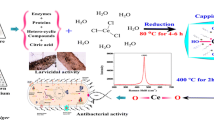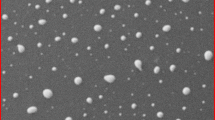Abstract
The bioactivity of three kinds of multi-walled carbon nanotubes (MWCNT) towards the conidia of entomopathogenic fungus Isaria fumosorosea was examined in an in vitro study. Commercial—raw and functionalized—carboxylated MWCNT were applied. A fungal conidia suspension was placed in contact with dispersed MWCNT over different time-periods. After contact with the nanomaterial, the conidia were cultured on dishes and both the linear vegetative mycelium growth and the sporulation and germination of the spores derived from the culture were investigated. Also, the pathogenicity of the conidia after contact with MWCNT was examined in relation to test larvae. No fungistatic activity of MWCNT relative to I. fumosorosea conidia was demonstrated. Conidia contact with MWCNT resulted in the following changes in vital processes in the subsequent culture compared to the control standard culture: (1) raw MWCNT limited mycelium inoculation, but the growth rate observed later in the log-phase was more intense; (2) after 24-h conidia contact with all MWCNT types, the mycelium sporulated the most intensively; longer contact resulted in sporulation process limitation. Germination of conidia after contact with the MWCNT was not significantly modified. Raw MWCNT potentiated conidia pathogenicity towards test insects. It was observed that carboxylation of MWCNT reduces the bioactivity of this nanomaterial towards the investigated conidia.




Similar content being viewed by others
References
Ago, H., Kugler, T., Cacialli, F., Salaneck, W. R., Shaffer, M. S. P., Windle, A. H., et al. (1999). Work functions and surface functional groups of multiwall carbon nanotubes. Journal of Physical Chemistry B, 103, 8116–8121.
Arias, L. R., & Yang, L. (2009). Inactivation of bacterial pathogens by carbon nanotubes in suspensions. Langmuir, 25, 3003–3012.
Auffan, M., Flahaut, E., Thill, A., Mouchet, F., Carrière, M., Gauthier, L., et al. (2011). Ecotoxicology: nanoparticle reactivity and living organisms. In P. Houdy, M. Lahmani, & F. Marano (Eds.), Nanoethics and nanotoxicology (pp. 325–357). Berlin, Heidelberg: Springer. doi:10.1007/978-3-642-20177-6_14.
Augustyniuk-Kram, A., & Kram, K. J. (2012). Entomopathogenic fungi as an important natural regulator of insect outbreaks in forests (Review) In: J. A. Blanco (Ed.), Forest Ecosystems - More than Just Trees. InTech: Available from: http://www.intechopen.com/books/forestecosystems-more-than-just-trees/entomopathogenic-fungi-as-an-important-natural-regulator-of-insectoutbreaks-in-forests-review.
Avilés, F., Cauich-Rodríguez, J. V., Moo-Tah, L., May-Pat, A., & Vargas-Coronado, R. (2009). Evaluation of mild acid oxidation treatments for MWCNT functionalization. Carbon. doi:10.1016/j.carbon.2009.06.044.
Behler, K., Osswald, S., Ye, H., Dimovski, S., & Gogotsi, Y. (2006). Effect of thermal treatment on the structure of multi-walled carbon nanotubes. Journal of Nanoparticle Research. doi:10.1007/s11051-006-9113-6.
Datsyuk, V., Kalyva, M., Papagelis, M., Parthenios, J., Tasis, D., Siokou, A., et al. (2008). Chemical oxidation of multiwalled carbon nanotubes. Carbon. doi:10.1016/j.carbon.2008.02.012.
Ebbole, D. J. (2010). The conidium. In K. A. Borkovich & D. J. Ebbole (Eds.), Cellular and molecular biology of filamentous fungi (pp. 577–590). Washington: ASM Press.
Gorczyca, A., Kasprowicz, M. J., & Lemek, T. (2009a). Physiological effect of multi-walled carbon nanotubes (MWCNTs) on conidia of the entomopathogenic fungus, Paecilomyces fumosoroseus (Deuteromycotina: Hyphomycetes). Journal of Environmental Science and Health. Part A, Toxic/Hazardous Substances & Environmental Engineering. doi:10.1080/10934520903263603.
Gorczyca, A., Kasprowicz, M., Lemek, T., & Jaworska, M. (2009b). The influence of multi-walled carbon nanotubes (MWCNTs) on viability of Paecilomyces fumosoroseus (Wise) Brown & Smith (Deuteromycotina: Hyphomycetes) fungus spore. Ecological Chemistry and Engineering A, 16(7), 765–770.
Gorczyca, A., Kasprowicz, M. J., & Lemek, T. (2014a). Physiological effect of multi-walled carbon nanotubes (MWCNTs) on conidia and development of the entomopathogenic fungus, Metarhizium anisopliae (Metsch.) Sorok. Journal of Environmental Science and Health. Part A, Toxic/Hazardous Substances & Environmental Engineering. doi:10.1080/10934529.2014.867217.
Gorczyca, A., Kasprowicz, M. J., & Lemek, T. (2014b). Physiological aspects of the interaction of multi-walled carbon nanotubes with Beauveria bassiana (Balsamo) Vuillem in entomopathogenic spores. Journal of Environmental Science and Health. Part A, Toxic/Hazardous Substances & Environmental Engineering. doi:10.1080/10934529.2014.882684.
Hamilton, R. F., Jr., Wu, Z., Mitra, S., Shaw, P. K., & Holian, A. (2013a). Effect of MWCNT size, carboxylation, and purification on in vitro and in vivo toxicity, inflammation and lung pathology. Particle and Fibre Toxicology. doi:10.1186/1743-8977-10-57.
Hamilton, R. F., Jr., Xiang, C., Li, M., Ka, I., Yang, F., Ma, D., et al. (2013b). Purification and sidewall functionalization of multiwalled carbon nanotubes and resulting bioactivity in two macrophage models. Inhalation Toxicology. doi:10.3109/08958378.2013.775197.
Hsu, J.-P., & Spasic, A. M. (2010). Interfacial electroviscoelasticity and electrophoresis. NW: CRC Press.
Hunter, R. J. (1981). Zeta potential in colloid science. London: Academic.
Hussain, A., Tian, M.-Y., Ahmed, S., & Shahid, M. (2012). Current status of entomopathogenic fungi as mycoinecticides and their inexpensive development in liquid cultures In: M-D. García (Ed.) Zoology, InTech: Available from: http://www.intechopen.com/books/zoology/current-status-of-entomopathogenic-fungi-as-mycoinecticides-andtheir-inexpensive-development-in-liq.
Jackson, P., Jacobsen, N. R., Baun, A., Birkedal, R., Kühnel, D., Jensen, K. A., et al. (2013). Bioaccumulation and ecotoxicity of carbon nanotubes. Chemistry Central Journal. doi:10.1186/1752-153X-7-154.
Jin, F.-L., & Park, S.-J. (2011). A review of the preparation and properties of carbon nanotubes-reinforced polymer compositess. Carbon Letters, 12(2), 57–69.
Kang, S., Mauter, M. S., & Elimelech, M. (2008). Physicochemical determinants of multiwalled carbon nanotube bacterial cytotoxicity. Environmental Science and Technology, 42, 7528–7534.
Karousis, N., Tagmatarchis, N., & Tasis, D. (2010). Current progress on the chemical modification of carbon nanotubes. Chemical Reviews. doi:10.1021/cr100018g.
Kundu, S., Wang, Y., Xia, W., & Muhler, M. (2008). Thermal stability and reducibility of oxygen-containing functional groups on multiwalled carbon nanotube surfaces: a quantitative high-resolution XPS and TPD/TPR study. Journal of Physical Chemistry C. doi:10.1021/jp804413a.
Lemek, T., Mazurkiewicz, J., Stobiński, L., Lin, H. M., & Tomasik, P. (2007). Non-covalent functionalization of multi-walled carbon nanotubes with organic aromatic compounds. Journal of Nanoscience and Nanotechnology, 7, 3081–3088.
Liu, S., Wei, L., Hao, L., Fang, N., Chang, M. W., Xu, R., et al. (2009). Sharper and faster nano darts kill more bacteria: a study of antibacterial activity of individually dispersed pristine single-walled carbon nanotube. ACS Nano, 3, 3891–3902.
Liu, Z., Dong, X., Song, L., Zhang, H., Liu, L., Zhu, D., et al. (2014). Carboxylation of multiwalled carbon nanotube enhanced its biocompatibility with L02 cells through decreased activation of mitochondrial apoptotic pathway. Journal of Biomedical Materials Research. Part A. doi:10.1002/jbm.a.34729.
Luangsa-Ard, J. J., Hywel-Jones, N. L., Manoch, L., & Samson, R. A. (2005). On the relationships of Paecilomyces sect. Isarioidea species. Mycological Research. doi:10.1017/S0953756205002741.
Ma, P.-C., Siddiqui, N. A., Marom, G., & Kim, J.-K. (2010). Dispersion and functionalization of carbon nanotubes for polymer-based nanocomposites: a review. Composites: Part A, 41, 1345–1364.
Monthioux, M. (2007). Introduction to carbon nanotubes. Springer Handbook of Nanotechnology (2nd ed.). New York: Springer.
Ramsden, J. (2011). Nanotechnology: an Introduction (pp. 189–198). New York: William Andrew, Norwich.
Sahoo, N. G., Rana, S., Cho, J. W., Li, L., & Chan, S. H. (2010). Polymer nanocomposites based on functionalized carbon nanotubes. Progress in Polymer Science. doi:10.1016/j.progpolymsci.2010.03.002.
Spitalsky, Z., Tasis, D., Papagelis, K., & Galiotis, C. (2010). Carbon nanotube-polymer composites: chemistry, processing, mechanical and electrical properties. Progress in Polymer Science. doi:10.1016/j. progpolymsci.2009.09.003.
Stobinski, L., Lesiak, B., Kövér, L., Tóth, J., Biniak, S., Trykowski, G., et al. (2010). Multiwall carbon nanotubes purification and oxidation by nitric acid studied by the FTIR and electron spectroscopy methods. Journal of Alloys and Compounds, 501, 77–84.
Stobinski, L., Lesiak, B., Zemek, J., & Jiricek, P. (2012). Time dependent thermal treatment of oxidized MWCNTs studied by the electron and mass spectroscopy methods. Applied Surface Science. doi:10.1016/j.jallcom.2010.04.032.
Wang, X. F., Chen, X. M., Yoon, K., Fang, D. F., Hsiao, B. S., & Chu, B. (2005). High flux filtration medium based on nanofibrous substrate with hydrophilic nanocomposite coating. Environmental Science & Technology, 39(19), 7684–7691.
Xia, W., Wang, Y., Bergsträer, S., Kundu, S., & Muhler, M. (2007). Surface characterization of oxygen-functionalized multi-walled carbon nanotubes by high-resolution X-ray photoelectron spectroscopy and temperature-programmed desorption. Applied Surface Science. doi:10.1016/j.apsusc.2007.07.120.
Yang, C., Mamouni, J., Tang, Y., & Yang, L. (2010). Antimicrobial activity of single-walled carbon nanotubes: length effect. Lugmuir, 26(20), 16013–16019.
Yu, H., Jin, Y., Peng, F., & Wang, H. (2008). Kinetically controlled side-wall functionalization of carbon nanotubes by nitric acid oxidation. Journal of Physical Chemistry C. doi:10.1021/jp711975a.
Zimmermann, G. (2008). The entomopathogenic fungi Isaria farinosa (formerly Paecilomyces farinosus) and the Isaria fumosorosea species complex (formerly Paecilomyces fumosoroseus): biology, ecology and use in biological control. Biocontrol Sci Techn, 18(9), 865–901.
Acknowledgments
We would like to thank Dr. Magdalena Oćwieja from the Institute of Catalysis and Surface Physicochemistry, PASci, and Dr. Olga Woźnicka from the Institute of Zoology, Jagiellonian University in Krakow, for their help in SEM and TEM imaging of the nanomaterials used in the study. The study was supported by University of Agriculture in Krakow Grant DS 3109/KOŚR.
Author information
Authors and Affiliations
Corresponding author
Electronic Supplementary Material
Below is the link to the electronic supplementary material.
Fig. A
TEM (left) and SEM (right) imaging of MWCNT used in the experiment (raw MWCNT – a, b; MWCNT(COOH)x A – c, d and MWCNT(COOH)x B – e, f) (GIF 724 kb)
Fig. B
AFM imaging of MWCNT(COOH)x A (left) and MWCNT(COOH)x B (right) used in the experiment (GIF 61 kb)
Rights and permissions
About this article
Cite this article
Gorczyca, A., Kasprowicz, M.J. & Lemek, T. Bioactivity of MWCNT in Conidia of Entomopathogenic Fungus Isaria fumosorosea . Water Air Soil Pollut 226, 75 (2015). https://doi.org/10.1007/s11270-015-2350-5
Received:
Accepted:
Published:
DOI: https://doi.org/10.1007/s11270-015-2350-5




